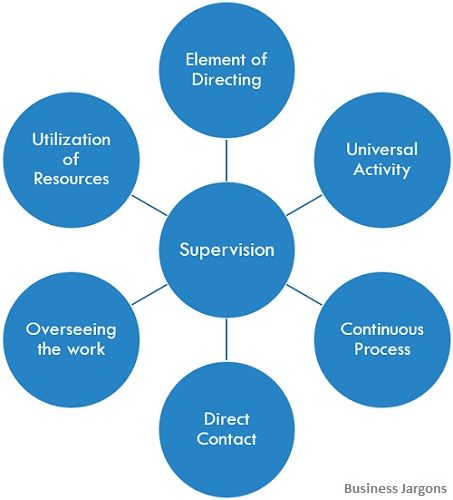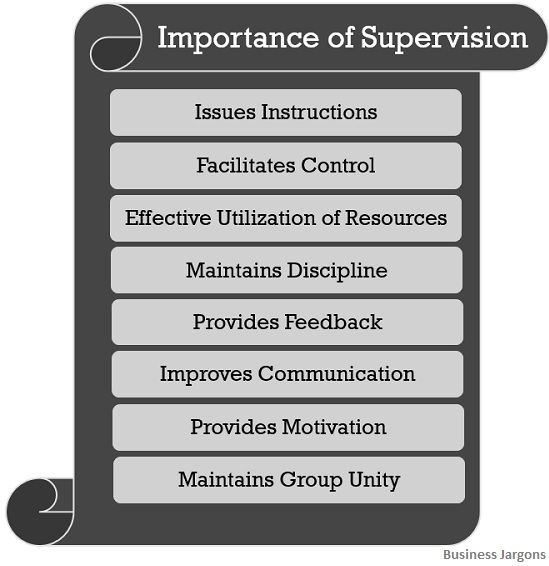Definition: Supervision implies one to one and prompt guidance provided to the employees, along with instructing, monitoring and controlling them when they carry out any task or job to check if they are working according to the organization’s plans and policies, in a timely manner. Besides this, supervision also involves resolving the issues and work-related problems of the employees.
It is a conjunction of two words – ‘super‘ and ‘vision‘ which refers to over and above and to see or view. In a nutshell, supervision means overseeing the activities of the employees.
Characteristics of Supervision
The characteristics of supervision are discussed below:
- Element of Directing: Supervision is one of the four important elements of directing. The other three being – motivation, communication and leadership.
- Universal activity: Supervision is a very common activity, which is required at different levels of management.
- Continuous Process: Constant and frequent supervision is required by the employees to perform various tasks as well as to resolve issues related to the work or job which occur abruptly.
- Direct Contact: The two parties involved in the process of supervision are – Supervisor and Subordinate. Hence, there is a direct and one to one contact between the two.
- Overseeing work: Supervision is done with an aim of guiding as well as keeping an eye on the work performed by the employees, to ensure that they are working in an appropriate manner. Also, there are no deviations from the plans, policies and objectives of the concern.
- Utilization of Resources: It facilitates optimum utilization of resources, which leads to the elimination of wastage and achieving maximum output at minimum cost.
Supervision aims to ensure that the employees work in an efficient and effective way, to accomplish the tasks satisfactorily, which is assigned to them, by their supervisor.
Importance of Supervision
The importance of supervision is given as under:
1. Issues Instructions: At the time of providing supervision to the subordinates. The supervisors give orders and instructions which are material, as to the performance of the tasks. These orders and instructions play an important role in initiating, modifying and terminating the activities. Therefore, it is the supervision which inducts the work, as well as follows it up, in a number of steps, until it is done.
2. Facilitates control: Supervision entails overseeing and observing the activities performed by the workers. So, it keeps a check on the methods, techniques and procedures used to perform the task, along with the progress of the work overtime, in relation to the set schedule.
Further, evaluation of the actual performance against the standard performance is done, and comparison is made to see if there are any deviations. On the identification of any deviations, corrective measures are taken to keep the performance in line with the organization’s objectives.
Therefore, it ensures control over the worker’s activities and conforms that work is performed according to the plans and policies.
3. Effective Utilization of Resources: A supervisor gives all the training to the front line workers as to how to operate machinery, tools and equipment, how to use materials and what precautions are to be taken while operating the machinery, etc, which prevents wastage.
Along with that, he/she gives them the instructions regarding what is to be done and what not to be done, by them. In this way, supervision ensures optimum utilization of the resources, be it human or physical.
4. Maintains Discipline: If a person is aware of the fact that his/her work is under constant observation and it is going to be checked by someone else, then the chances of mistakes and errors become very less. And in such a case proper discipline is maintained in the organization.
5. Provides Feedback: In the process of supervision, the supervisor comes in direct contact with the workers. Hence, feedback in the form of suggestions, reviews, grievances and complaints, regarding the work comes from the top management, which is provided to the workers by the Supervisor. This ensures maintenance of the quality of management decisions.
6. Improves Communication: The supervisor acts as a connection between workers and management. Hence, it improves open communication between the two, as the workers can convey their requests, and suggestions easily to the top management. In the same way, orders, instructions, reviews and suggestions are transmitted by the top management to the workers.
7. Provides Motivation: While providing supervision to the subordinates, he/she motivates the workers for improving their performance and productivity and boosts their morale.
8. Maintains Group Unity: Supervision also helps in maintaining the group unity and team spirit among the workers working in the organization. The supervisor works for keeping the workers together and maintaining harmony among them.
Who is a Supervisor?
A supervisor is a person who assigns tasks to the subordinates and keeps an eye on their activities and performance. Basically, the first-line managers, which are working at the function level management are termed as Supervisors. This is due to the fact that the main work of the first-line managers is to supervise the workers involved in the day to day operations.
Alternatively, the first-line managers are also known as foreman, superintendent, chargeman, section in charge, etc.
Functions of Supervisor
- Maintains a direct and day to day contact with the functional level staff and maintain a healthy relationship with them.
- Explain all the rules, clarify the instructions and also advise the employees to work in cooperation with one another as a team.
- Prepares a schedule of the tasks and activities to be performed by the subordinates, to facilitate a continuous and uninterrupted flow of work.
- Conveys the orders and instructions which are given to the subordinates and ensures full-fledged compliance.
- Ensures that the subordinates have all the facilities and tool and equipment, which are required to perform the task.
- Keeps a close watch and directs the activities of the subordinates, to carry out the task.
- Coordinates the work and efforts of numerous subordinates working under his/her control and also maintains unity among them.
- Acts as a knot between workers and management.
- Identifies mistakes, errors and omissions, and takes corrective actions.
- Ensures the performance of the worker is as per the set target.
- Provides feedback to the workers about their strengths, weaknesses and performance.
In a nutshell, supervision means to oversee the tasks and activities performed by the subordinates and giving guidance and instructions to them, to ensure effective utilization of the organization’s resources and achievement of targets.

Eddah Githiri says
This is very insightful.